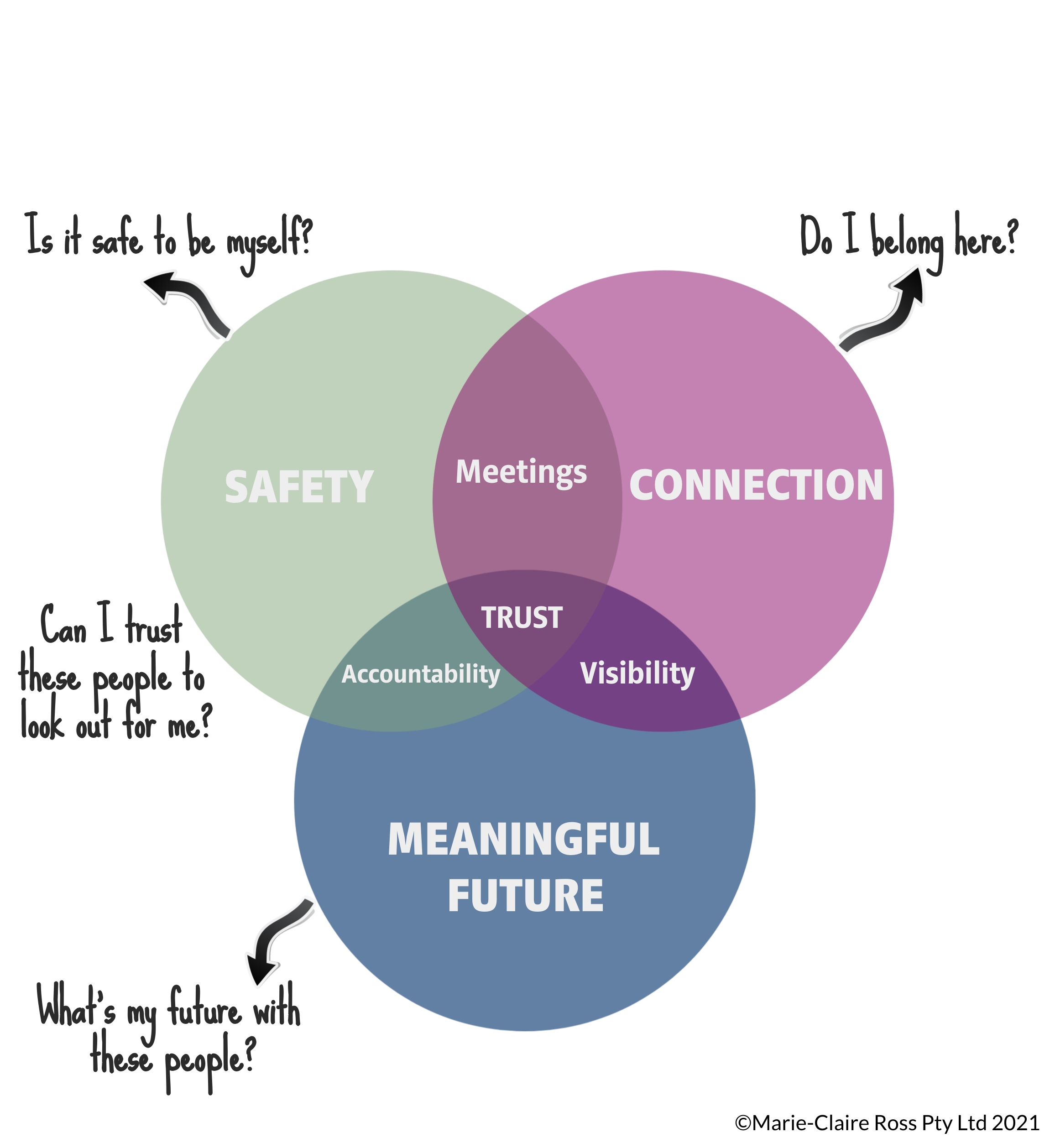
Over the years, I’ve worked with many CEOs across Australia from predominantly midsize companies. Some will complain about their people not being fully productive or...
In today’s fast-paced world, we often don’t have the luxury of time to build trust for time-sensitive projects. The ability to react quickly and adapt is critical. Teams must be put together quickly, decisions made and deadlines met.
As a team leader, there are so many different aspects of your job - allocating resources, sharing information, gathering information, nudging others and prioritising work. The list goes on.
But the most vital resource that you need to allocate daily is your time. It is easy to forget that manpower, capital and money can be made available. But your own time is finite. Precious. Worthy of your undivided attention to allocate and preserve. In fact, it has been claimed that how you handle your own time, is the single most important aspect of being a role model and leader.
And one of the most critical places to spend your time is to maximise the output of your team.
As Andy Grove said in the iconic book, High Output Management, the output of a team leader is a result achieved by a team either under her supervision or under her influence.
Your productivity as a manager is the productivity of your team.
A critical part of your job is to look for ways to make things truly better in your department. Every hour of your day should be spent increasing the output or the value of the output of the people you’re responsible for.
Essentially, high managerial productivity is a combination of choosing to perform tasks that possess high leverage and elicit peak performance from the individuals within the team. This includes activities that protect your time so it doesn't get wasted in people and project issues that could have been avoided.
Better leveraging your time takes time, skill and trust. Time to empower subordinates to make the right decisions, communicate the strategic vision and understand your expectations. Skill to elicit peak performance from your team. And trust that your team members and even your peers can be relied upon to do the right thing.
Trust is the key because without it, everything slows down. It's like wading through sludge - decisions take longer, people work around one another and avoid sharing errors or important information. A lack of trust requires more effort on behalf of the team leader to increase team impact.
And if trust is broken, it is extremely difficult to repair taking on average five months according to a study by Towers Watson.
Learning how to build trust quickly and sustainably is key to your ability to get things done more easily through people.
One of the biggest issues to building trust with others is that we all struggle with a subconscious fear that causes us to hold back, avoid speaking up and contribute at our fullest. Psychologists call this interpersonal risk. It is the fear that people won’t think highly of us or at an extreme level will reject us altogether.
As Amy Edmondson explains in her book, The Fearless Organisation, the free exchange of ideas, concerns or questions is routinely hindered by interpersonal fear more often than most leaders realise.
Interpersonal risk stops us from asking questions, speaking up about our concerns or reporting errors. In other words, the critical elements required for improving performance and averting disaster in team discussions.
That's why team leaders that know how to reduce interpersonal risk help build trust more quickly with those around them.
So how do you reduce interpersonal risk?
When we don’t trust someone it’s because we believe at a deep emotional level that they have the capacity to hurt us. Fear is a lack of trust. If you’re leading a newly formed team, you need to encourage people to believe that you have their best interests at heart. And you can’t do this by saying “you can trust me on this!”
The part of the brain responsible for feelings such as trust and loyalty has no capacity for language. That’s why just talking about improving trust with others doesn’t work as we process whether we can trust someone through our emotions. We don’t trust others by what they say, it’s how they make us feel. It’s their consistent actions that show that they care about our well-being that determine whether we feel we can or cannot trust them.
You can’t talk your way into trust; you have to behave your way into it. And this requires leaders learn techniques that signal to people (both verbally and nonverbally) that everything will be okay.
According to neuroscience, if you want to get people to trust you quickly, you need to focus on three factors that the brain requires to perform well at work.

They are:
1. CREATING PSYCHOLOGICAL SAFETY
In the workplace, employees need to see and feel evidence that their workplaces are safe and that their fellow co-workers are looking out for them. More importantly, workers need to trust that their boss and colleagues really care.
What people need to thrive in their jobs is psychological safety. They want to work in an organisation where they can be themselves, speak up about any concerns and that if they make a mistake they won’t be criticised. They know they can work the extra mile and their effort will be noticed. This feeling of psychological safety enables employees to become more emotionally invested in the organisation they work in. It means they’re more likely to work harder and be engaged in their work.
According to Google, psychological safety is by far the most important out of all the dynamics they measured in a high-performance team.
To build trust quickly, you need to focus on creating a safe space for people to bring their best selves to work. Do this by acknowledging every team member through eye contact in meetings, inviting each person to speak, expressing gratitude and rewarding excellence.
We are biologically wired to want to be with other people. Having a sense of connection to those around us improves our well-being. Yet, we often receive conflicting messages at work that we need to focus on tasks and not waste time making friends.
Neuroscience experiments show that when people intentionally build social ties at work, their performance improves. Those that have high trust levels at work have more meaningful relationships and feel both secure in and loyal to their group. They also know they have support when they need it.
Furthermore, we trust people who are similar to ourselves. You can unite people together, no matter how different they are, by aligning them to the company purpose or a really compelling goal.
Other ways to bring people together are by introducing employees to other colleagues in other departments, talking about what makes your company great and how the group achieves more than what an individual can achieve on their own. Give teams time to socialise and talk about things that are non-task related.
2. FOCUSING ON A MEANINGFUL FUTURE
When we don't know what is going to happen next, the situation feels unsafe. It means we hold back our commitment to our jobs and team members. People love to be engaged in a future that seems better than the present day. Focusing on a positive future pulls people out of the anxiety zone and into the achievement zone in the brain.
It is important to help people see that the organisation is going somewhere, as well as their team and career.
When people have clear direction, understand the meaning of their role and how it contributes to the success of the organisation, they feel as though their contribution matters. Their work inspires them to get out of bed each morning excited to go to work.
Essentially, people love their job, if it matters if they show up to work because their work makes a difference.
When employees understand their overall role in the business 91% will work towards that success, but the number plummets to 23% if they don’t (Bill Quirke, Melcrum).
As a leader, it’s vital that you reduce uncertainty by letting people know where the company is headed and why. When employees feel that communication is ambiguous or they don’t understand what is expected of them, they fall into fear and low trust.
To improve this, clearly communicate accountability structures, set clear expectations and align employees with a mutual purpose. Ensure that you align individual’s self-interest to the greater impact of the organisation. Once people are clear on what is expected of them, make sure that you let them know how their performance is positively impacting those around them.
BUILDING TRUST QUICKLY
Learning how to build trust sustainably is key to creating speed in your team. You have to make time to save time. And the fastest way is to communicate to those around you that they are safe, connected and share a bright future.
If you want to learn more effective techniques that will reduce your leadership effort and double your team's accountability, discover my FAST TRUST leadership development program.

Over the years, I’ve worked with many CEOs across Australia from predominantly midsize companies. Some will complain about their people not being fully productive or...
With the rate of change and uncertainty in the world, CEOs think about trust regularly – no matter the size of their organisation.